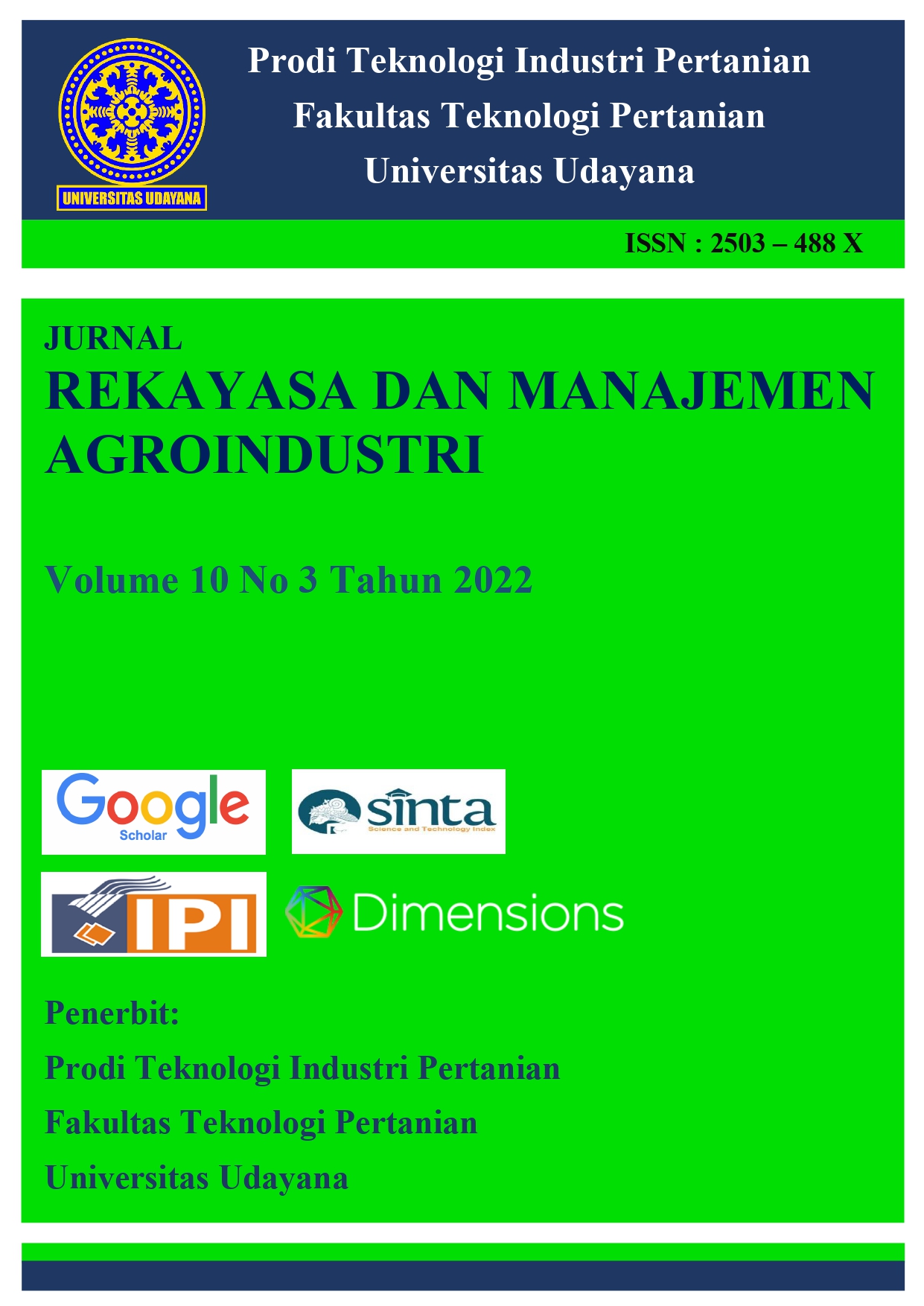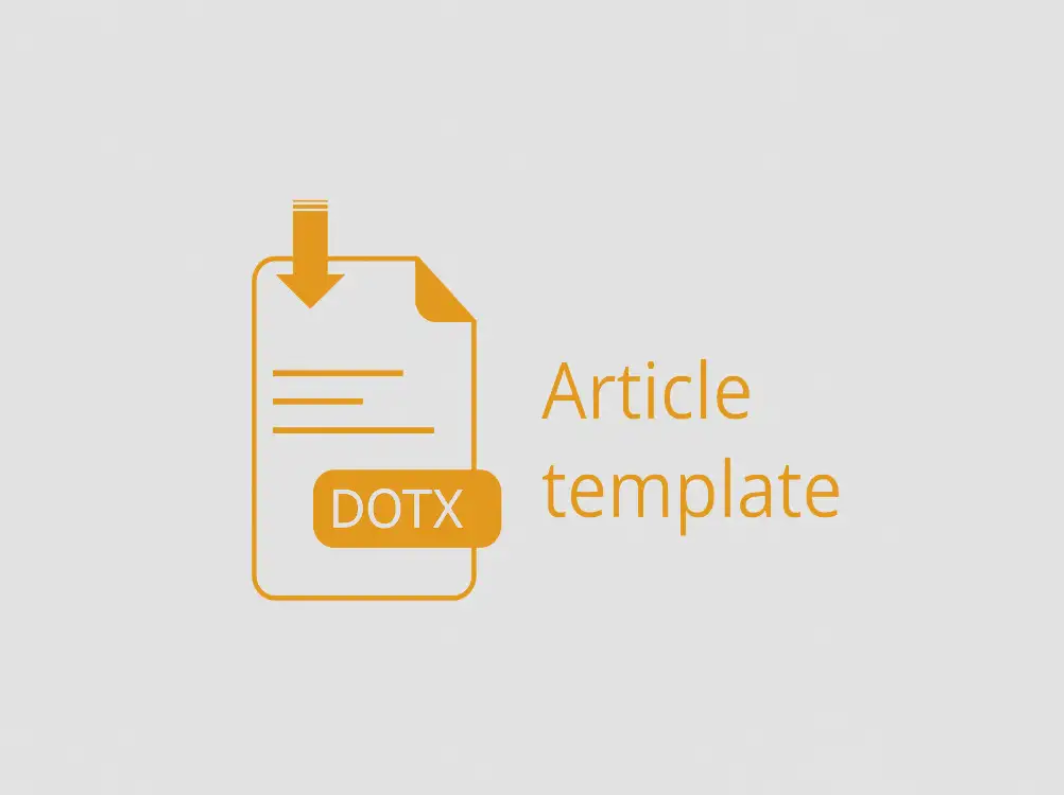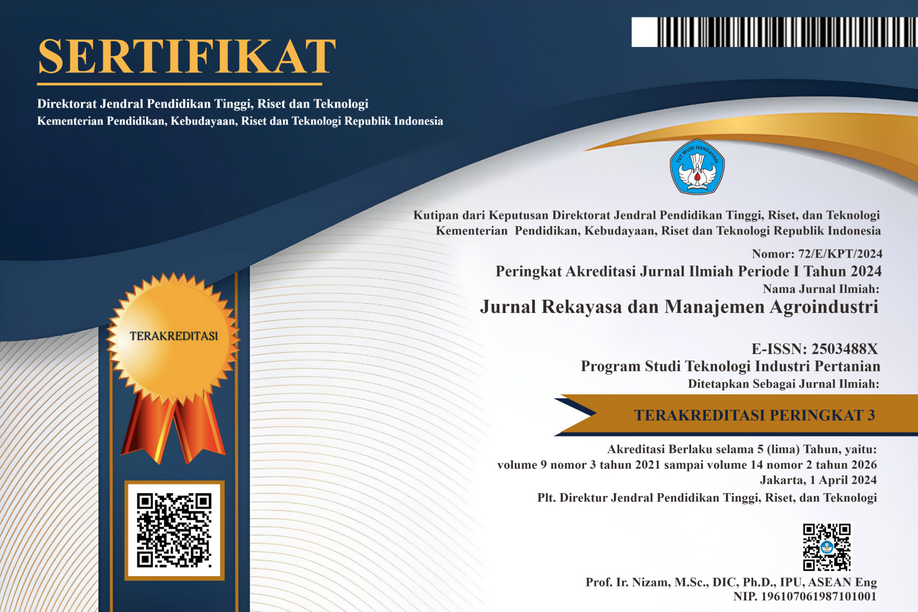PENGARUH KONSENTRASI HIDROGEN PEROKSIDA DAN WAKTU PROSES BLEACHING TERHADAP KARAKTERISTIK SELULOSA SERAT SABUT KELAPA (Cocos nucifera L.)
Abstract
Indonesia is the largest coconut producing country in the world. The abundant potential of coco fiber has not been fully utilized optimally. The purpose of this study was to determine the effect of hydrogen peroxide concentration and time of the bleaching process on the cellulose’s characteristics of coconut fiber, as well as to determine the concentration of hydrogen peroxide and time of the bleaching process to produce cellulose from coconut fiber with the best characteristics. This study used a factorial Randomized Block Design with two treatment factors, namely the concentration of H2O2 (K) (20%, 30% and 40%) and the bleaching process time (W) (60 minutes and 120 minutes). Variables observed were yield, degree of whiteness, cellulose, hemicellulose and lignin. The concentration of hydrogen peroxide and the time of the bleaching process affect the yield, whiteness, cellulose, hemicellulose and lignin on cellulose of coconut fiber. The interaction between treatments affected the degree of whiteness, cellulose, hemicellulose, and lignin but had no effect on the yield of the bleached coconut fiber. The best treatment in the bleaching process to produce cellulose from coco fiber is the combination of 40% hydrogen peroxide concentration and 120 minutes of bleaching time. The cellulose characteristics of coco fiber produced were yield, whiteness, cellulose, hemicellulose and lignin is 38.45±2.51%, 76.23±1.54%, 90.19±0.66 %, 5.53±0.58%, and 3.66±0.18%, respectively.
Downloads
References
[2] J. Towaha, G. Indriati, and Rusli, “Komponen buah dan fitokimia daging buah kelapa genjah,” Agrin, vol. 12, no. 1, pp. 23-34., 2008.
[3] A. Saleh, M. M. D. Pakpahan, and N. Angelin, “Pengaruh konsentrasi pelarut, temperatur, dan waktu pemasakan pada pembuatan pulp dari sabut kelapa muda,” J. Tek. Kim., vol. 16, no. 3, pp. 35–44, 2009.
[4] D. Tooy, E. M. R. Mukuan, and L. H. Sue, “Kajian log chain industri sabut kelapa di sulawesi utara, indonesia,” Agro Bali Agric. J., vol. 4, no. 3, pp. 403–417, 2021.
[5] I. W. Sudiarta and W. D. Sulihingtyas, “Biosorpsi Cr(Iii) pada biosorben serat sabut kelapa hijau teramobilisasi edta,” J. Kim., vol. 6, no. 1, pp. 29–36, 2012.
[6] N. P. S. Ayuni and P. N. Hastini, “Serat sabut kelapa sebagai bahan kajian pembuatan bioetanol dengan proses hidrolisis asam,” J. Sains dan Teknol., vol. 9, no. 2, pp. 102–110, 2020.
[7] S. Mawaddah, Misgiya, W. T. Atmojo, and S. Wiratma, “Tinjauan kerajinan berbahan sabut kelapa di sentra crearbush desa mulyorejo kecamatan sunggal deli serdang,” J. Seni Rupa, vol. 09, no. 01, pp. 44–49, 2020.
[8] N. Masruchin and Subyakto, “Investigation characteristics of pulp fibers as green potential polymer reinforcing agents,” J. Sains Mater. Indones., vol. 13, no. 2, pp. 90–96, 2012.
[9] F. P. Sari, M. Ghozali, R. Damayanti, W. Fatriasari, and E. Hermiati, “Peranan serat alang-alang (Imperata cylindrica) sebagai penguat kertas daur ulang,” Maj. Polim. Indones., vol. 21, no. 1, pp. 1–19, 2018.
[10] A. B. Pitaloka, N. A. Hidayah, and M. Nasikin, Asep Handaya Saputra, “Pembuatan cmc dari selulosa eceng gondok dengan media reaksi campura larutan isopropanol-isobutanol untuk mendapatkan viskositas dan kemurnian tinggi,” Integr. Proses, vol. 5, no. 2, pp. 108–114, 2015.
[11] H. J. Malmiri, A. Osman, C. P. Tan, and R. A. Rahman, “Evaluation of effectiveness of three cellulose derivative-based edible coatings on changes of physico-chemical characteristics of ‘Berangan’ banana (Musa sapientum cv. Berangan) during storage at ambient conditions,” Int. Food Res. J., vol. 18, no. 4, pp. 1381–1386, 2011.
[12] L. W. N. Setyaningsih, T. Mutiara, C. Y. Hapsari, N. Kusumaningtyas, H. Munandar, and R. J. Pranata, “Karakteristik dan aplikasi selulosa kulit jagung pada pengembangan hidrogel,” J. Sci. Appl. Technol., vol. 4, no. 2, p. 61, 2020.
[13] W. Fatriasari, R. Raniya, M. Oktaviani, and E. Hermiati, “The improvement of sugar and bioethanol production of oil palm empty fruit bunches (Elaeis guineensis Jacq) through microwave-assisted maleic acid pretreatment,” BioResources, vol. 13, no. 2, pp. 4378–4403, 2018.
[14] D. P. Dewanti, “Potensi selulosa dari limbah tandan kosong kelapa sawit untuk bahan baku bioplastik ramah lingkungan,” J. Teknol. Lingkung., vol. 19, no. 1, pp. 81–88, 2018.
[15] Y. A. Paskawati, Susyana, Antaresti, and E. S. Retnoningtyas, “Pemanfaatan sabut kelapa sebagai bahan baku pembuatan kertas komposit alternatif,” J. Widya Tek., vol. 9, pp. 12–21, 2010.
[16] S. L. Tondang, “Pembuatan Dan Karakterisasi Film Berbasis Cmc Hasil Eterifikasi Selulosa Sabut Kelapa Dengan Asam Monokloroasetat Menggunakan Plasticizer Polivinil Alkohol,” Universitas Sumatera Utara, 2018.
[17] R. B. Helenius G, Backdahl H, Bodin A, Nannmark U, Gatenholm P, “In vivo biocompatibility of bacterial cellulose,” J Biomed Mater Res A, vol. 76, no. 2, p. 431, 2006.
[18] H. R. Permatasari, F. Gulo, and B. Lesmini, “Pengaruh konsentrasi H2SO4 dan NaOH terhadap delignifikasi serbuk bambu (Gigantochloa Apus),” J. Penelit. Pendidik. Kim., vol. 1, no. 2, pp. 131–140, 2015.
[19] L. Lismeri, Y. Darni, M. D. Sanjaya, and M. I. Immadudin, “Pengaruh suhu dan waktu pretreatment alkali pada isolasi selulosa limbah batang pisang,” J. Chem. Process Eng., vol. 4, no. 1, 2019.
[20] Jufrinaldi, “Isolasi selulosa dari bagas tebu melalui pemanasan iradiasi gelombang mikro,” J. Ilm. Tek. Kim., vol. 2, no. 2, pp. 36–46, 2018.
[21] I. G. N. J. A. Prasetia, I. G. N. A. D. Putra, D. A. M. I. P. Arsana, and N. P. M. Prabayanti, “Studi karakteristik farmasetis mikrokristalin selulosa dari jerami padi varietas lokal bali,” J. Sains Mater. Indones., vol. 17, no. 3, pp. 119–123, 2016.
[22] E. Wolok, I. H. Lahay, B. R. Machmoed, and F. Pakaya, “Analisis pengaruh perlakuan oksidasi terhadap jumlah selulosa dan kekuatan mekanik serat sabut kelapa,” Semin. Nas. Teknol. dan Rekayasa, vol. 4, pp. 11–22, 2019.
[23] Y. Sun and J. Cheng, “Hydrolysis of lignocellulosic materials for ethanol production: a review,” Bioresour. Technol., vol. 83, no. 1, pp. 1–11, 2001.
[24] I. B. W. Gunam, K. Buda, and I Made Yoga Semara Guna, “Pengaruh perlakuan delignifikasi dengan larutan NaOH dan konsentrasi substrat jerami padi terhadap produksi enzim selulase dari Aspergillus niger NRRL A-II, 264,” J. Biol., vol. 14, no. 1, pp. 55–61, 2010.
[25] R. Hartono, Jayanuddin, and Salamah, “Pemutihan pulp eceng gondok menggunakan proses ozonasi,” Semin. Rekayasa Kim. dan Proses, pp. 1–5, 2010.
[26] H. Irfanto, Padil, and Y. A, “Proses bleaching pelepah sawit hasil hidrolisis sebagai bahan baku nitroselulosa dengan variasi suhu dan waktu reaksi,” Pap. Knowl., pp. 1–9, 2014.
[27] R. S. D. Lestari and D. K. Sari, “Pengaruh konsentrasi H2O2 terhadap tingkat kecerahan pulp dengan bahan baku eceng gondok melalui proses organosolv,” J. Integr. Proses, vol. 6, no. 1, pp. 45–49, 2016.
[28] P. W. Sena, G. P. G. Putra, and L. Suhendra, “Karakterisasi selulosa dari kulit buah kakao ( Theobroma cacao L . ) pada berbagai konsentrasi hidrogen peroksida dan suhu proses bleaching,” J. Rekayasa dan Manaj. Agroindustri, vol. 9, no. 3, pp. 288–299, 2021.
[29] Sunardi, N. Noviyanti, W. T. Istikowati, K. Nisa, and M. Anwar, “Analisis komponen serat pelepah sagu (Metroxylon Sago) dan kajian morfologi selulosanya setelah oksidasi menggunakan amonium persulfat,” J. Sains dan Terap. Kim., vol. 15, no. 1, pp. 48–63, 2021.
[30] AOAC and Kenneth Helrich, Official Methods of Analysis, Fifteenth. Arlington, VA, 1999.
[31] C. Weaver, The Food Chemistry Laboratory. Boca Roton, 1996.
[32] R. Datta, “Acidogenic fermentation of lignocellulose–acid yield and conversion of components,” Biotechnol. Bioeng., vol. 23, no. 9, pp. 2167–2170, 1981.
[33] H. Onggo and T. Astuti, “Pengaruh sodium hidroksida dan hidrogen peroksida terhadap rendemen dan warna pulp dari serat daun nenas,” J. Ilmu Teknol. Kayu Trop. Vol., vol. 3, no. 1, pp. 37–43, 2005.
[34] Sri Hidayati, Ribut Sugiharto, and Ahmad Sapta Zuidar, “Karakteristik pulp hasil pemutihan dari tandan kosong kelapa sawit hasil pemasakan yang menggunakan limbah lindi hitam siklus ketiga,” J. Trop. Upl. Resour. (J. Trop. Upl. Res.), vol. 1, no. 1, pp. 103–108, 2019.
[35] I. W. Arnata, Suprihatin, F. Fahma, N. Richana, and T. C. Sunarti, “Cellulose production from sago frond with alkaline delignification and bleaching on various types of bleach agents,” Orient. J. Chem., vol. 35, no. 1, pp. 08–19, 2019.
[36] Dendis Elfiska Royyani, “Optimasi Proses Bleaching Pada Proses Pembuatan Proses Pembuatan Kertas Seni Berbahan Baku Serat Pinang Sirih (Areca catechu L .) Mengggunkan Response Surface Method (Kajian Lama Waktu Bleaching dan Kadar H2O2),” Universtas Brawijaya, 2018.
[37] dan R. S. Rodsamran, P., “Renewable cellulose source:isolation and characterisation of cellulose from rice stubble residues.,” Int. J. Food Sci. Technol., vol. 50, no. 9, pp. 1953–1959, 2015.
[38] Y. A. Prawira, “Pengaruh Waktu dan Konsentrasi H2O2 pada Pemutihan Pulp Serbuk Gergaji Sengon dengan Metode Penambahan Tekanan Autoklaf dan Ohmic Heating,” 2019.
[39] Jayanudin, R. Hartono, and N. H. Jamil, “Pengaruh konsentrasi dan waktu pemutihan serat daun nanas menggunakan hidrogen peroksida,” Semin. REKAYASA Kim. DAN PROSES, pp. 1–6, 2010.

Ciptaan disebarluaskan di bawah Lisensi Creative Commons Atribusi-BerbagiSerupa 4.0 Internasional.
Seluruh artikel di Jurnal ini dapat disebarluaskan atas tetap mencantumkan sumber yang syah. Identitas judul artikel tidak boleh dihilangkan. Penerbit tidak bertangggung jawab terhadap naskah yang dipublikasikan. Isi artikel menjadi tanggung jawab Penulis.














